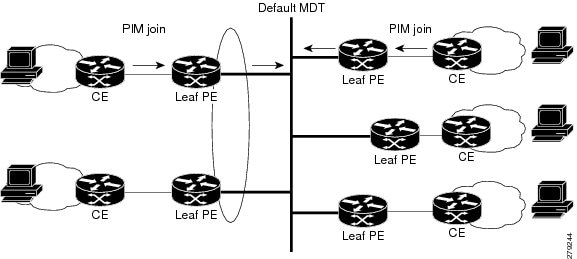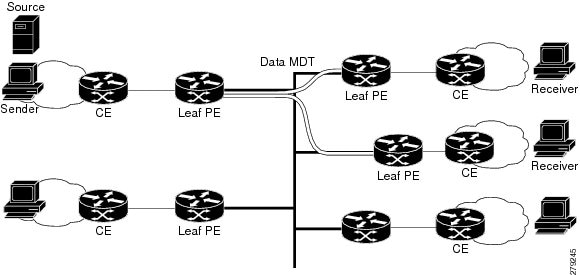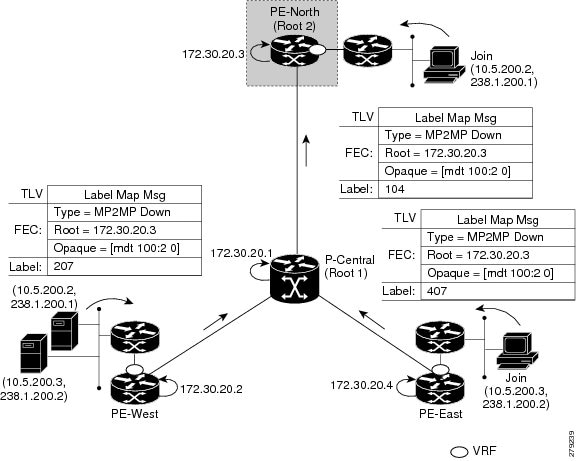PIM operates over the LSP-VIF as if it were a regular tunnel interface. That means PIM hellos are exchanged over the LSP-VIF
to establish PIM adjacencies over the default MDT. The sample output in this section displays the three PIM adjacencies in
VRF of PE-East. The listed entried here are the adjacencies to PE-West and PE-North over the MP2MP LSP via LSP-VIF interface
101.
PE-East# show ip pim vrf vrf3001 neighbor
PIM Neighbor Table
Mode: B - Bidir Capable, DR - Designated Router, N - Default DR Priority,
P - Proxy Capable, S - State Refresh Capable, G - GenID Capable,
L - DR Load-balancing Capable
Neighbor Interface Uptime/Expires Ver DR
Address Prio/Mode
5.5.5.5 Lspvif0 00:18:54/00:01:33 v2 1 / S P G
2.2.2.2 Lspvif0 1d00h/00:01:34 v2 1 / S P G
22.22.22.22 Lspvif0 1d00h/00:01:34 v2 1 / DR S P G
The output from the show
ip
mroute command also shows the (S, G) entry for VRF. The stream 225.1.1.1 has the Reverse Path Forwarding (RPF) interface of LSP-VIF
interface 101 and the neighbor 2.2.2.2, which is PE-West.
PE-East# show ip mroute vrf vrf3001 225.1.1.1 30.22.1.10
IP Multicast Routing Table
Flags: D - Dense, S - Sparse, B - Bidir Group, s - SSM Group, C - Connected,
L - Local, P - Pruned, R - RP-bit set, F - Register flag,
T - SPT-bit set, J - Join SPT, M - MSDP created entry, E - Extranet,
X - Proxy Join Timer Running, A - Candidate for MSDP Advertisement,
U - URD, I - Received Source Specific Host Report,
Z - Multicast Tunnel, z - MDT-data group sender,
Y - Joined MDT-data group, y - Sending to MDT-data group,
G - Received BGP C-Mroute, g - Sent BGP C-Mroute,
N - Received BGP Shared-Tree Prune, n - BGP C-Mroute suppressed,
Q - Received BGP S-A Route, q - Sent BGP S-A Route,
V - RD & Vector, v - Vector, p - PIM Joins on route,
x - VxLAN group, c - PFP-SA cache created entry,
* - determined by Assert, # - iif-starg configured on rpf intf,
e - encap-helper tunnel flag
Outgoing interface flags: H - Hardware switched, A - Assert winner, p - PIM Join
Timers: Uptime/Expires
Interface state: Interface, Next-Hop or VCD, State/Mode
(30.22.1.10, 225.1.1.1), 00:31:08/00:02:14, flags: JTY
Incoming interface: Lspvif101, RPF nbr 2.2.2.2, MDT: [2, 2.2.2.2]/00:02:51
Outgoing interface list:
Vlan3001, Forward/Sparse, 00:31:08/00:02:35










 Feedback
Feedback